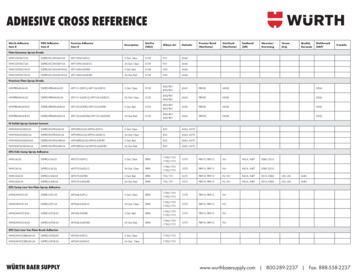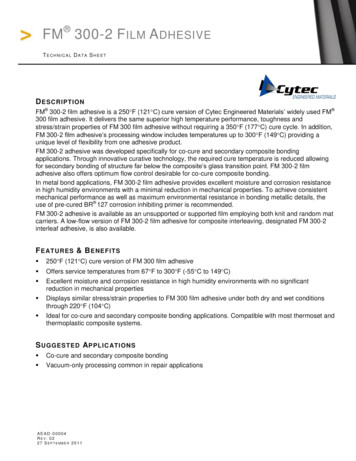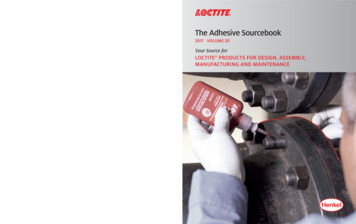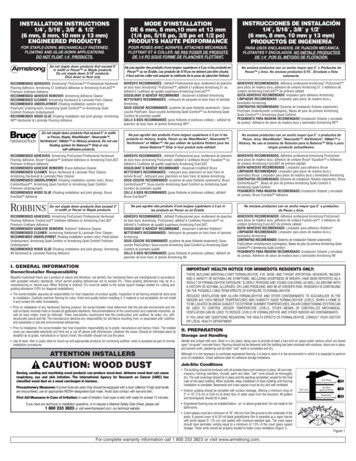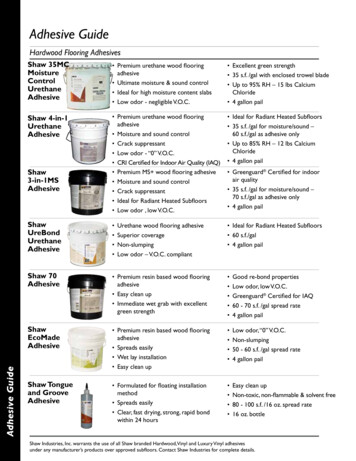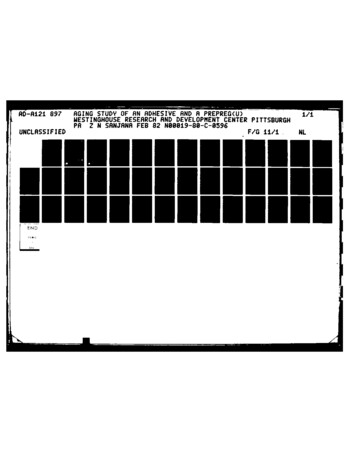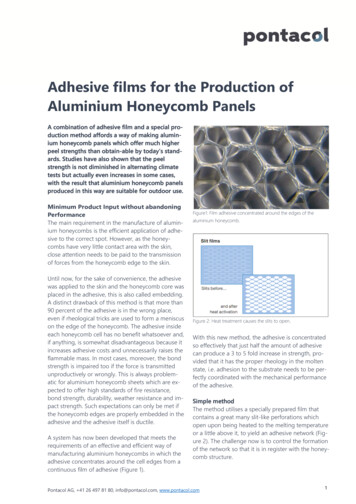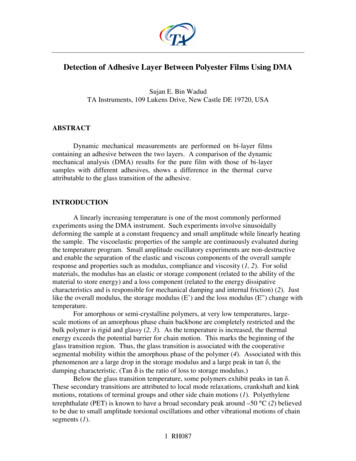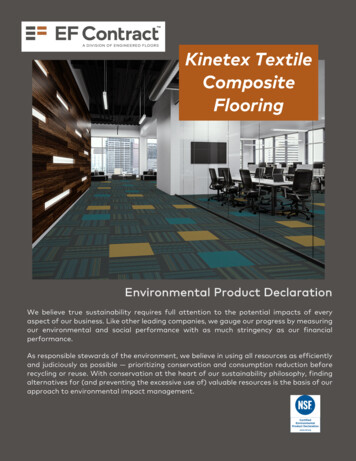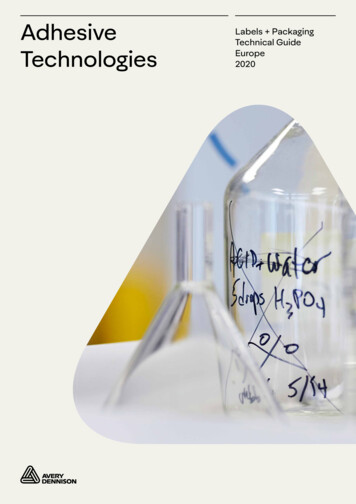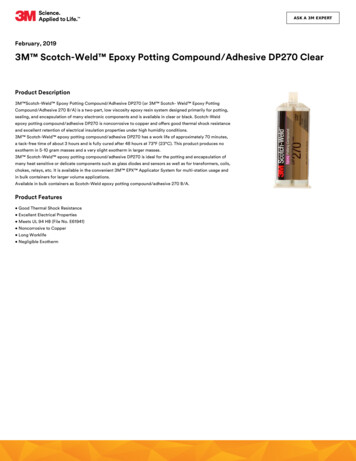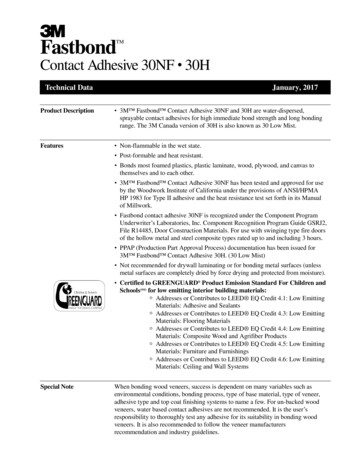
Transcription
3FastbondTMContact Adhesive 30NF 30HTechnical DataJanuary, 2017Product Description 3M Fastbond Contact Adhesive 30NF and 30H are water-dispersed,sprayable contact adhesives for high immediate bond strength and long bondingrange. The 3M Canada version of 30H is also known as 30 Low Mist.Features Non-flammable in the wet state. Post-formable and heat resistant. Bonds most foamed plastics, plastic laminate, wood, plywood, and canvas tothemselves and to each other. 3M Fastbond Contact Adhesive 30NF has been tested and approved for useby the Woodwork Institute of California under the provisions of ANSI/HPMAHP 1983 for Type II adhesive and the heat resistance test set forth in its Manualof Millwork. Fastbond contact adhesive 30NF is recognized under the Component ProgramUnderwriter’s Laboratories, Inc. Component Recognition Program Guide GSRJ2,File R14485, Door Construction Materials. For use with swinging type fire doorsof the hollow metal and steel composite types rated up to and including 3 hours. PPAP (Production Part Approval Process) documentation has been issued for3M Fastbond Contact Adhesive 30H. (30 Low Mist) Not recommended for drywall laminating or for bonding metal surfaces (unlessmetal surfaces are completely dried by force drying and protected from moisture). Certified to GREENGUARD Product Emission Standard For Children andSchools(SM) for low emitting interior building materials: Addresses or Contributes to LEED EQ Credit 4.1: Low EmittingMaterials: Adhesive and Sealants Addresses or Contributes to LEED EQ Credit 4.3: Low EmittingMaterials: Flooring Materials Addresses or Contributes to LEED EQ Credit 4.4: Low EmittingMaterials: Composite Wood and Agrifiber Products Addresses or Contributes to LEED EQ Credit 4.5: Low EmittingMaterials: Furniture and Furnishings Addresses or Contributes to LEED EQ Credit 4.6: Low EmittingMaterials: Ceiling and Wall SystemsSpecial NoteWhen bonding wood veneers, success is dependent on many variables such asenvironmental conditions, bonding process, type of base material, type of veneer,adhesive type and top coat finishing systems to name a few. For un-backed woodveneers, water based contact adhesives are not recommended. It is the user’sresponsibility to thoroughly test any adhesive for its suitability in bonding woodveneers. It is also recommended to follow the veneer manufacturersrecommendation and industry guidelines.
3M Fastbond Contact Adhesive 30NF 30HTypical PhysicalPropertiesProductNote: The following technical information and data should be considered representativeor typical only and should not be used for specification purposes.3M Fastbond Contact Adhesive30NF3M Fastbond Contact Adhesive 30H(30 Low Mist in een when wet. Darker green when dry.Green (Wet), Darker Green (Dry)Neutral, White (Wet), Clear (Dry)Net Weight:8.9 - 9.3 lbs./gal.8.9 - 9.3 lbs./gal.Solids (by wt):47-51%45-50%Solvent(s):WaterMethanol 2%Toluene 3%WaterEthanol 2%Xylene 3%Flash Point:None – Setaflash closed cup testerNone – Setaflash closed cup testerCoverage:(@ 3 gms/ft2dry)680 sq. ft./gal.680 sq. ft./gal.Viscosity:Brookfield Viscometer:200-750 cpsRVF #2 sp. @ 20 rpm @ 80 F5500-9500 cpsRVF #4 sp. @ 20 rpm @ 77 F-2-
3M Fastbond Contact Adhesive 30NF 30HHandling/ApplicationInformationDirections For Use:1. Surface Preparation: Surfaces must be clean, dry and dust free. Wiping with asolvent such as 3M Solvent No. 3* will aid in removing oil and dirt.Temperature of adhesive and surfaces during fabrication should be at least 65 F(18 C). If used for decorative plastic laminates, the laminate should have reachedmoisture equilibrium for the shop conditions.2. Application: Apply a uniform, generous coat of adhesive to both surfaces with anylon brush, roller (texturing type), or spray. One coat is usually sufficient on mostsurfaces. Dull spots when dry indicate insufficient adhesive. Very porous materialmay require more than one coat. (Allow adhesive to dry completely between coats.)A uniform, glossy film indicates sufficient adhesive.3. Coverage: Coverage is dependent upon porosity of the substrate and the method bywhich the adhesive is applied. Use 3.0-3.5 gms/ft2 of dry adhesive per surface forwood, particle board and high pressure laminates with the adhesive applied byspray or roller. More adhesive (lower coverage) is recommended if very soft wood,fabrics, foams, etc. are to be bonded, or if the adhesive is applied by brushing.4. Drying Time: The adhesive dries sufficiently in 30 minutes under normaltemperatures and humidities to make bonds. High humidity will slow the drying;high temperature will speed the drying. After the adhesive is dry the bond must becompleted within four hours.5. Assembly: Spacers, such as dowels or strips of laminate, may be used to helpprevent premature adhesive to adhesive contact and bonding prior to positioning.Slide out the spacers and apply uniform pressure, working toward the edges.A 3 in. wide (maximum) roller with maximum body pressure should be used tohelp ensure adequate contact and bonding, especially on edges. Bonded assembliesmay be machined, trimmed, etc. immediately after bonding. The use of a pinch ornip roll is preferred for optimum performance.6. Cleanup: If adhesive has not dried, clean equipment with water containing a smallamount of detergent.** Adhesive cannot be cleaned off rollers or brushes after ithas dried.*When using solvents, extinguish all ignition sources, including pilot lights, andfollow the manufacturer’s precautions and directions for use.**Cleaning solution: One pint of cleaner to five gallons of water. Flush with cleanwater.-3-
3M Fastbond Contact Adhesive 30NF 30HHandling/Application (1)Information (continued)(2) Working Temperature: The adhesive and both surfaces to be bonded should be 65 F(18 C) or above at the time of bonding. After storage at low temperature and beforeusing, the adhesive must be warmed to room temperature. Do not place in oven or onstove; bring to temperature by placing in a warm room. If this is not done, the open timeand other working properties of the adhesive may be adversely affected.Use Enough Adhesive: It is important to remember that it is difficult to use too muchadhesive, but you can have problems if you don’t use enough. 3M Fastbond Contact Adhesive 30NF must be applied to both surfaces. Adhesive can be applied byspray (see Application Equipment Suggestions), brush or a texturing type roller.Non-porous surfaces should require only one coat, while porous surfacesmay require two coats. Wherever you use more than one coat, be sure tolet the adhesive dry completely between coats. Hardwoods, temperedhardboard and decorative laminates are non-porous. Soft woods, untemperedhardboard, plywood and plaster are typical porous surfaces which may requiretwo coats.Note: 3M water-dispersed contact adhesives should never be thinned.Let Adhesive Dry Completely: Under normal temperature and humidity conditions,3M Fastbond Contact Adhesive 30NF will dry in approximately 30 minutes. Invery warm, low humidity conditions, drying may take as little as 10-15 minutes. Lowertemperatures and higher humidity mean slower drying. When the adhesive coatingcompletely loses its milky appearance and becomes clear it is ready to bond. You havefour (4) hours after the adhesive is dry in which to complete the bonding job. You canbond as soon as it is dry, but the longer you wait the stronger the initial bond will be.To speed drying, infrared heat lamps may be used. When force drying isused, assembly and bonding must be completed while one or both of thebonding surfaces is warm. If both surfaces are cold, reheat either or bothbefore bonding.If your two surfaces do not grab onto each other immediately when broughtinto contact, the adhesive has dried too long or not enough adhesive wasapplied. In either case, another coat of adhesive over each surface will remedythe problem.Apply Pressure Thoroughly: Bonding is immediate upon contact. Sustainedpressure is not required, but good uniform pressure must be applied to every squareinch of the surface. Apply pressure by using heavy body pressure on a small (notover 3”) hand “J”-roller. The use of a pinch roll is preferred for optimumperformance.Note: Rolling pins and other wide rollers are unsatisfactory because theybridge low spots and because they distribute the pressure over too largean area.Assembling: Position the surfaces carefully before assembly. No adjustmentis possible after the adhesive films make contact. Use the paper slip sheetmethod or spacers to position large pieces.Finishing: Bonded assemblies can be machined, trimmed and finishedimmediately after bonding.-4-
3M Fastbond Contact Adhesive 30NF 30HHandling/ApplicationInformation (continued)Cleaning: Brushes or rollers which are to be reused should be wrapped withplastic wrap to keep adhesive wet as complete cleaning is difficult.Note: Never pour solvent onto a bonded surface; it will attack the adhesiveline and weaken the bond. Just wipe with cloth dampened in solvent orcleaner such as 3M Citrus Base Cleaner.* Turpentine will notdissolve the adhesive.*When using solvents, extinguish all ignition sources, including pilotlights, and follow the manufacturer’s precautions and directions for use.Application EquipmentSuggestionsNote: Appropriate application equipment can enhance adhesive performance. Wesuggest the following application equipment for the user’s evaluation in lightof the user’s particular purpose and method of application.1. Air Atomizing Spray EquipmentHand Held teAir RequirementFluid Flow*Binks 2001SS, 9566SD65SS10-15 psi6 scfm @ 20 psi9-12 fl. oz./min.#30FF10-15 psi6 scfm @ 20 psi9-12 fl. oz./min.94F30 psi11 scfm @ 30 psi9-12 fl. oz./min.66SD65SS10-15 psi6 scfm @ 20 psi9-12 fl. oz./min.95P94F30 psi11 scfm @ 30 psi9-12 fl. oz./min.DeVilbiss MSA-510H.V.L.P. (high volume, low pressure)Binks Mach 195PAutomatic Spray ApplicatorsBinks No. 95AH.V.L.P. Mach 1A*To measure fluid flow: Pressurize fluid source only; pull trigger; flow material into measuring devicefor 60 seconds; increase or decrease fluid source pressure to obtain desired fluid flow.Note: Low pressure, air operated piston pumps should not be used with these products.2. Pressure Pot: Polyethylene liner. Dip tube and fittings should be plastic or stainless steel.3. Pumping Equipment: 1 in. plastic diaphragm pump with PTFE checks and diaphragms such asmanufactured by Warren Rupp Co.4. Filter: (pump output) Graco model 12 (stainless steel) with filter bag #521-264 or equivalent. Or 300micron mesh equivalent.5. Airless Spray: This product can be airless sprayed. Fluid tips ranging from .018 in. to .031 in. at fluidpressures up to 1,100 psi are normally used.6. Hoses: All material hoses should be nylon or polyethylene lined with plastic or stainless steel fittings.7. Roll Coating: 3M Fastbond Contact Adhesive 30H may be coated with a machine type roll coatersuch as manufactured by Black Bros., Mendota, IL. Roll covering should be urethane with 24 groovesper inch for most applications.-5-
3M Fastbond Contact Adhesive 30NF 30HApplication EquipmentSuggestions (conti nued)Typical Automatic Spray System1. Screen, Binks #41-26622. 3/4 in. PVC Plastic pipe, approximately 3 ft.3. Nylon based hose, 3/4 in. ID, Binks #71-284, with#72-417 hose fittings, approximately 4 ft. long.4. 3/4 to 1 in. NPT Plastic reducer nipple.5. Pump 1 in. plastic diaphragm pump with PTFE checks anddiaphragm such as manufactured by Warren Rupp Co.6. 11/2 in. ID, NPT Plastic reducer nipple.7. Nylon lined hose, 1/2 in. ID, Binks #71-283, with#72-1334 fittings.8. 1/2 to 11/2 in., NPT Plastic reducer nipple.9. Graco Model 12 (stainless steel) with filter bag#521-264 or equivalent.10. 11/2 in. to 3/8 in., NPT Plastic reducer nipple.11. Nylon lined hose, 3/4 in. ID, Binks #71-282, with#72-1328 fittings.12. Automatic spray gun Binks #95A with stainlesssteel fluid tip #65 and #66SD air cap.Note: Polyethylene tubing may be substituted fornylon lined hose.Typical Laminating Line1. Conveyor: Conveyor should be adjusted to give the requireddrying time. For example, a conveyor speed of 10 feet perminute with a 10-foot long oven will give a drying time of60 seconds.2. Reciprocating Spray Machine and Spray Booth.3.4.5.6.Drying Oven.Lay-Up Area.Nip Rolls.Take Off TableStart Up, Maintenance and Shut Down for Automatic Spray Lines:Water-based adhesives differ from solvent based adhesives in two major respects:1.Dried water-based adhesive will not dissolve in the wet adhesive.2.The presence of water in the system creates the potential for corrosion of or reaction with certain metals, such as copper, brass, steel,aluminum, etc. As a result, extra care is required to assure proper functioning of spray equipment. The attached schematic of a suggested spraysystem, start-upprocedure for this system, and suggested maintenance program, were developed with the properties of 3M water-based adhesives in mind.Start-Up Procedure for Air Atomizing Spray System with Rupp Pump1. Connect pump to piping system. Flush lines and pipes with hot, soapy water* to remove possible contaminants before attaching pump or spraygun. Flush thoroughly with clean water. Blow out excess water. Do not connect fluid line to spray applicator.2. If pump has not been supplied with air regulator, attach regulator and gauge to air inlet of pump.3. Close air inlet valve on pump and attach regulator inlet to air supply.4. Adjust regulator to “0” pressure reading on the gauge.5. Open air inlet valve all the way and tighten lock nut.6. Insert suction tube in adhesive so that inlet to tube is at bottom of container.7. Direct end of fluid hose into a waste container.8. Start pump by increasing regulated inlet air pressure (approximately 5 psi will be required).9. Run pump until all traces of air are out of the system and adhesive is flowing in a steady, uninterrupted stream.10. Shut off pump by reducing inlet air pressure to “0” psi or disconnecting inlet air line from regulator.11. Immediately connect fluid hose to spray applicator.12. Turn on pump and manually trigger applicator a few times to purge air from applicator.13. Set flow rate of spray applicator by increasing or decreasing inlet air pressure to pump (normally 5-30 psi).14. Adjust atomizing air pressure and fan air to obtain desired spray pattern (normally 10-20 psi).*Cleaning solution: One pint detergent to five gallons of water. Flush with clean water.-6-
3M Fastbond Contact Adhesive 30NF 30HApplication EquipmentSuggestions (continued)Maintenance Program1. Filter: Follow the manufacturer’s instructions for disassembling filter. Removedirty filter bag and replace with clean bag. Do not allow adhesive to dry.Reassemble filter immediately.2. Pump: To remove pump from system for cleaning, disconnect fluid line at outletof pump and insert threaded plug into fluid line to prevent drying of adhesive.Remove suction line from adhesive and place in 5 gallons of soapy water.** Flushthrough the pump. Disconnect siphon line at inlet to pump and invert pump toallow water to drain out. Follow disassembly instructions to remove manifold,diaphragms and valves. Soak these parts in 3M Adhesive Remover orequivalent until adhesive has been sufficiently loosened and can be rubbed off.*Dry parts overnight at room temperature or 2 to 3 hours at 120 F (49 C) beforereassembling pump. Do not install parts until all odor is gone. If pump must bereturned to service quickly, a second set of diaphragms and valves should bepurchased and installed while the first set is being cleaned. To put the pump backinto operation, follow steps 6 through 12 in Start-Up Procedure.3. Spray Applicator: Should the fluid tip become plugged, shut off pump byreducing inlet air pressure to “0” psi, or disconnect inlet air. Manually triggerapplicator to relieve pressure in fluid lines. Remove tip, wipe any particles fromfluid needle with damp cloth and immediately install a clean fluid tip. (Note: Fluidtips must be stainless steel.) Do not allow adhesive to dry in applicator or tip.Plugged tip may be rinsed in water and soaked in mineral spirits, followed bybrushing with stiff bristle brush to remove adhesive. Air caps which becomecoated with adhesive should be replaced with clean caps. Soak adhesive coatedcaps in mineral spirits to clean.**When using solvents, extinguish all ignition sources, including pilot lights, andfollow the manufacturer’s precautions and directions for use.**Cleaning solution: One pint cleaner to five gallons of water. Flush with cleanwater.Attention:1. Do not use fluid lines that have previously been used with solvents whetherflammable or non-flammable.2. Do not use “rubber” lined hose. Hose should be either flexible polyethyleneor nylon lined. All hose and pipe fittings should be plastic or stainless steel.DO NOT use copper, aluminum, brass or steel fittings.3. A pressure pot may be used in place of the pump. In this case, a polyethylenebag liner should be used. Also the DIP TUBE AND FITTINGS SHOULD BECHANGED TO PLASTIC OR STAINLESS STEEL.-7-
3M Fastbond Contact Adhesive 30NF 30HTypical AdhesivePerformanceCharacteristicsNote: The following technical information and data should be considered representativeor typical only and should not be used for specification purposes.T-Peel StrengthCanvas/CanvasTest Temp.75 F (24 C)75 F (24 C)75 F (24 C)75 F (24 C)75 F (24 C)75 F (24 C)-30 F (-37 C)150 F (66 C)180 F (82 C)Overlap Shear Strength1 8” Birch 1 8” BirchTime @ 75 F Value (lbs./inch width)1 Day3572 wks.3 wks.3 wks.3 wks.3 wks.25353020201551010Test Temp.Value (psi)-30 F (-37 C)75 F (24 C)180 F (82 C)200 F (93 C)225 F (107 C)1100480603040Flatwise Tensile Test: High pressure laminate/particle board.Test speed 0.05 in./min.Test Temperature75 F (24 C)150 F (66 C)180 F (82 C)200 F (93 C)*Particle board failure3M Fastbond Contact Adhesive 30-NF*113 psi55 psi30 psi27 psiActivation of Pre-Applied AdhesiveSections of high pressure laminate were sprayed with adhesive, dried, and thenstored at 75 F (24 C). Each month for nine months a piece of pre-coated laminatewas bonded to birch plywood that had been sprayed with adhesive and allowed todry for 10 minutes. The bonds were made in a pinch roller and then aged 3 weeksbefore testing.1/8 in. Birch/High-Pressure Laminate Shear Strength (lbs./sq. in.)Aging PeriodMonthsControl369Test Temp.75 F (24 C)265315305285Test Temp.150 F (66 C)130140150125Test Temp.180 F (82 C)30807550Note: Pre-applied adhesive must be kept free of dust and dirt. Pre-applied adhesivecan also be activated with 3M Contact Adhesives 5 and 1357.Surface FlammabilityTest conducted in accordance with ASTM E-286-69 “Surface Flammability ofBuilding Materials” using an eight (8) foot tunnel furnace.Test Results3M Fastbond Contact AdhesiveFlame Spread Index030-NFFuel Contributed Index0Smoke Density Index16.1Note: No flaming or odor emissions were present during testing. Adhesiveapplication amount was 2.95 gm./ft.2 dry.Moisture vapor transmission: MVP rating 0.0091 perm inches.-8-
3M Fastbond Contact Adhesive 30NF 30HStorageBest storage temperature is 60-80 F (16-27 C) for maximum storage life. Highertemperatures reduce normal storage life. Lower temperatures cause increasedviscosity of a temporary nature. These water-based contact adhesives will becomeunusable with prolonged storage below 40 F (4 C). Rotate stock on a “first-in,first-out” basis.Shelf LifeWhen stored at the recommended temperature in the original, unopened container,these products have a shelf life of 15 months.PrecautionaryInformationRefer to Product Label and Material Safety Data Sheet for health and safety information before using thisproduct. For additional health and safety information, call 1-800-364-3577 or (651) 737-6501.Technical InformationThe technical information, recommendations and other statements contained in this document arebased upon tests or experience that 3M believes are reliable, but the accuracy or completeness of suchinformation is not guaranteed.Product UseMany factors beyond 3M’s control and uniquely within user’s knowledge and control can affect the useand performance of a 3M product in a particular application. Given the variety of factors that can affectthe use and performance of a 3M product, user is solely responsible for evaluating the 3M product anddetermining whether it is fit for a particular purpose and suitable for user’s method of application.Warranty,Limited Remedy,and DisclaimerUnless an additional warranty is specifically stated on the applicable 3M product packaging or productliterature, 3M warrants that each 3M product meets the applicable 3M product specification at the time3M ships the product. 3M MAKES NO OTHER WARRANTIES OR CONDITIONS, EXPRESS ORIMPLIED, INCLUDING, BUT NOT LIMITED TO, ANY IMPLIED WARRANTY OR CONDITION OFMERCHANTABILITY OR FITNESS FOR A PARTICULAR PURPOSE OR ANY IMPLIED WARRANTYOR CONDITION ARISING OUT OF A COURSE OF DEALING, CUSTOM OR USAGE OF TRADE.If the 3M product does not conform to this warranty, then the sole and exclusive remedy is, at 3M’soption, replacement of the 3M product or refund of the purchase price.Limitation of LiabilityExcept where prohibited by law, 3M will not be liable for any loss or damage arising from the 3M product,whether direct, indirect, special, incidental or consequential, regardless of the legal theory asserted,including warranty, contract, negligence or strict liability.ISO 9001: 2000This Industrial Adhesives and Tapes Division product was manufactured under a 3M quality system registered to ISO 9001: 2000 standards.3Industrial Adhesives and Tapes Division3M Center, Building 225-3S-06St. Paul, MN 55144-1000800-362-3550 877-369-2923 (Fax)www.3M.com/sprayadhesives3M and Fastbond are trademarksof 3M.Setaflash is a registered trademarkof Erdco Engineering Corp. 3M 2016-9-
HP 1983 for Type II adhesive and the heat resistance test set forth in its Manual of Millwork. Fastbond contact adhesive 30NF is recognized under the Component Program Underwriter's Laboratories, Inc. Component Recognition Program Guide GSRJ2, File R14485, Door Construction Materials. For use with swinging type fire doors
